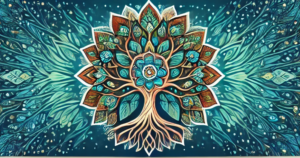(Part 2 of 3)
“In the mirror of narcissism, we find not only their wounds but our own strength to heal and rise.” — Shahida Arabi

Note: This post discusses narcissistic behaviors and their traumatic impact on targets. If you’re recovering from narcissistic abuse, know that your experience is valid, and healing is possible. Take care as you read.
Post 1 – From Narcissists to Energy Shapers: The Hungry Ghosts in Spiritual Communities – introduced Energy Shapers—narcissists and energy vampires who infiltrate spiritual communities, wielding manipulative tactics like love-bombing and spiritual jargon to drain energy, affecting 6.2% of adults with narcissistic traits (American Psychiatric Association, 2013). Their presence, often cloaked in charisma, exploits the trust and vulnerability of open-hearted individuals, leaving deep wounds that challenge core beliefs and identity. This post builds on that foundation, exploring how to identify Energy Shapers, the profound trauma they inflict across all contexts, and the dynamic between Shapers and empaths/healers, whose compassionate energy makes them frequent targets (Arabi, 2017). By understanding their impact, we lay the groundwork for healing, which Post 3 will address through practical strategies and TIPA’s trauma-informed support.
Narcissists, reframed as Energy Shapers, wield manipulative tactics like gaslighting, love-bombing, and devaluation to drain energy and sow discord, affecting 6.2% of adults with narcissistic traits (American Psychiatric Association, 2013). Their impact is profoundly traumatic, striking at the core of a target’s beliefs, identity, and trust, often leaving wounds that linger long after the relationship ends. While anyone can be targeted, spiritual communities—where trust and vulnerability are paramount—amplify this harm, exploiting the openness of individuals like empaths and healers (Arabi, 2017). This post explores how to identify Energy Shapers, the deep trauma they inflict across all contexts, and the dynamic between Shapers and empaths/healers, setting the stage for healing strategies in Post 3.
Identifying Energy Shapers: A Target’s Perspective
From a target’s perspective, an Energy Shaper’s presence can initially feel magnetic, even transformative. They may appear as charismatic leaders, empathetic allies, or vulnerable seekers, drawing you in with warmth and wisdom. However, their patterns soon betray a different reality. Grounded in the framework of Pentad 9: Ego’s Illusion, here are key signs to recognize, tied to their archetypal shadows (Myss, 2001; Jung, 1964):
- Inauthentic Persona: Energy Shapers craft a polished facade—often the “nice guy,” “empath,” or deploying archetypes like child, lover, or victim—to capture attention. They wield buzzwords like “authenticity” or “connection” to charm, but their actions lack depth or consistency (Grandiose Ego, Shape Shifter). You might feel an initial bond, only to notice misalignment over time (Durvasula, 2019).
- Excessive Attention-Seeking: Whether extroverted or introverted, they crave the spotlight. Extroverted Shapers dominate with grandiose tales, demanding praise (Grandiose Ego, Magician). Introverted ones play the victim, pleading, “you’re the only one who understands,” pressuring affirmation. You may feel overshadowed or obligated (Durvasula, 2019).
- Superficial Empathy: Their support feels performative, with platitudes like “I’m here for you” vanishing when you need help, leaving you depleted (Shamed Ego, Vampire).
- Boundary Violations: They push intimacy through love-bombing or dismiss limits, framing it as closeness, making you feel unsafe (Grandiose Ego, Shape Shifter) (Brown, 2016).
- Lack of Accountability: When confronted, they deflect with excuses or rhetoric like “you’re too sensitive” or “I don’t understand where this is coming from.” Alternatively, they may superficially accept responsibility without change (Shamed Ego, Trickster) (Brown, 2016).
- Energy Drain: Interactions leave you exhausted, anxious, or doubting yourself, a hallmark of their Vampire archetype (Martin, 2020).
As a target, you might question your perceptions, especially when others are charmed by the Shaper’s facade. Their skill at isolating targets amplifies this doubt. Trusting your intuition—feelings of unease or depletion—is essential for spotting patterns early (van der Kolk, 2014). Your instincts are a powerful guide, even if the Shaper appears widely liked and admired.
The Lasting Impact of Energy Shapers in Spiritual Communities
The trauma inflicted by Energy Shapers cuts to the core, often surpassing life’s most profound losses due to its relentless assault on beliefs, identity, and trust. This betrayal dismantles foundational convictions and fosters a pervasive sense of vulnerability that lingers long after the relationship ends (web:5, web:22).
- Core Belief Disruption: Energy Shapers’ tactics—gaslighting, love-bombing, devaluation—shatter beliefs about self-worth, trust, and reality. Even those generally skilled at spotting narcissists can be blindsided, leading to deep self-doubt and a fractured sense of identity. The question “How could I have been so wrong?” becomes a haunting refrain, eroding confidence in one’s judgment (web:6, web:21).
- Emotional and Psychological Toll: Targets endure anxiety, depression, hypervigilance, and symptoms akin to post-traumatic stress disorder, such as flashbacks, panic, or emotional numbness, sometimes termed Narcissistic Victim Syndrome (NVS). The trauma’s intensity stems from the Shaper’s exploitation of vulnerability, creating a cycle of self-blame and diminished self-esteem (web:5, web:10).
- Relational and Social Damage: Through triangulation or smear campaigns, Shapers isolate targets, sowing distrust in relationships and communities. This can lead to social withdrawal, fear of betrayal, and difficulty forming new connections, as the trauma infiltrates interpersonal dynamics (web:1, web:24).
- Long-Term Consequences: Without healing, targets may face chronic low self-esteem, self-destructive habits, or challenges in professional and personal spheres, as internalized shame takes hold. The trauma’s longevity lies in its ability to reshape how targets view themselves and the world (web:5, web:10).
In spiritual communities, the impact is amplified by the inherent framework of safety, trust, and vulnerability. The belief that such spaces are free from manipulation leads targets to lower their guard, making the Shaper’s betrayal particularly shattering. The openness encouraged in these circles, especially for empaths and healers, becomes a prime target for exploitation, intensifying feelings of violation and eroding faith in connection (web:6).
Yet, with healing, this trauma can become a catalyst for profound growth. From a higher perspective, healing targets self-awareness, empowering us to rediscover our authentic self and shed limiting beliefs (often already present at a deep unconscious level, but highlighted by the Shaper.) It fosters resilience, strengthening our ability to set boundaries and trust our intuition. Spiritually, it deepens connection to our soul’s purpose, often awakening a calling to hold space for others, as a Veyrin or healer, aligning with universal compassion through the high heart chakra. Healing rebuilds trust in relationships, enabling authentic connections, and integrates shadow and light, guiding us toward transcendence and unity (Arabi, 2017; web:10). This trauma is not your fault, and these positive outcomes are within reach.
Post 3 explores strategies to protect your energy and details how TIPA empowers targets to rebuild strength and trust, while guiding Shapers toward accountability to prevent further harm.
The Empath/Healer Dynamic with Energy Shapers
Energy Shapers are often drawn to empaths and healers, whose high energy derivation—compassion, emotional availability, and vibrant energy fields—makes them ideal sources for validation and control (Arabi, 2017; Myss, 2001). From the Shaper’s perspective, empaths and healers provide a renewable supply of attention, feeding their Shamed Ego’s need to mask insecurity, often through addictive behaviors like substance use or social media compulsion, which 50% of narcissists exhibit (web:13, web:15). Their charisma or vulnerability exploits empaths’ openness, creating dependency (Durvasula, 2019).
Empaths and healers, embodying the “wounded healer” archetype, may be drawn to Shapers, mistaking their intensity for depth or seeking to heal their wounds, driven by heart or high heart chakra energy (Brown, 2016; Martin, 2020). This mutual attraction creates a draining dynamic, where the empath/healer’s generosity fuels the Shaper’s validation cycle, often exacerbating their addictive tendencies (web:9).
Not all targets are empaths or healers. Anyone—drawn by trust, curiosity, or trauma (60% of survivors, van der Kolk, 2014)—can be affected. Empaths and healers are more vulnerable due to their radiant energy, which Shapers exploit (Grandiose Ego). TIPA prioritizes all targets’ healing, offering tools to reclaim energy and set boundaries, ensuring a safe space for recovery.
To navigate this dynamic:
- For Empaths/Healers: Recognize your compassion attracts Shapers, but their interest often serves their needs. Ground yourself (e.g., deep breathing) and set boundaries to limit over-giving (Neff, 2011).
- For Energy Shapers: Reflect on seeking high-energy individuals for validation, often tied to addictive patterns (web:14). Pause to assess intentions, fostering reciprocal connections (Young & Klosko, 1993).
- For All Targets: Trust your intuition and observe behaviors to ensure alignment (Kabat-Zinn, 1990).
Conclusion: Facing the Impact, Embracing Healing
Energy Shapers leave deep wounds, challenging our core beliefs and trust, with amplified harm in spiritual communities where safety and vulnerability are exploited. Yet, this trauma does not define us—it invites profound growth, from self-awareness to spiritual connection. By understanding their patterns and impact, we reclaim our power to heal. Post 3 – Navigating and Healing with TIPA – offers practical strategies to protect your energy, prompts self-reflection for accountability, and details how TIPA empowers targets to rebuild strength while guiding Shapers toward transformation, fostering safer spiritual communities. Join us at Rowan-Wellness.com/spark to explore this path.
References:
- American Psychiatric Association. (2013). Diagnostic and Statistical Manual of Mental Disorders (DSM-5). American Psychiatric Publishing. https://www.psychiatry.org/psychiatrists/practice/dsm
- Arabi, S. (2017). Becoming the Narcissist’s Nightmare: How to Devalue and Discard the Narcissist While Supplying Yourself. CreateSpace Independent Publishing Platform. https://www.amazon.com/Becoming-Narcissists-Nightmare-Narcissist-Supplying/dp/152370246X
- Brown, S. L. (2016). Women Who Love Psychopaths: Inside the Relationships of Inevitable Harm with Psychopaths, Sociopaths, and Narcissists. Mask Publishing. https://www.sandralbrownma.com/
- Durvasula, R. (2019). Don’t You Know Who I Am? How to Stay Sane in an Era of Narcissism, Entitlement, and Incivility. Post Hill Press. https://www.dr-ramani.com/
- Jung, C. G. (1964). The Archetypes and the Collective Unconscious. Princeton University Press. https://press.princeton.edu/books/paperback/9780691018331/archetypes-and-the-collective-unconscious
- Kabat-Zinn, J. (1990). Full Catastrophe Living: Using the Wisdom of Your Body and Mind to Face Stress, Pain, and Illness. Delacorte Press. https://www.mindfulnesscds.com/
- Martin, J. (2020). The Finders. Integration Press. https://www.drjeffreymartin.com/
- Myss, C. (2001). Sacred Contracts: Awakening Your Divine Potential. Harmony Books. https://www.myss.com/archetypes/
- Neff, K. (2011). Self-Compassion: The Proven Power of Being Kind to Yourself. William Morrow. https://self-compassion.org/
- van der Kolk, B. A. (2014). The Body Keeps the Score: Brain, Mind, and Body in the Healing of Trauma. Penguin Books. https://www.besselvanderkolk.com/resources/the-body-keeps-the-score
- Young, J. E., & Klosko, J. S. (1993). Reinventing Your Life: The Breakthrough Program to End Negative Behavior and Feel Great Again. Penguin Books. https://www.schematherapy.com/
- [Web:1] https://www.psychologytoday.com/us/blog/emotional-sobriety/202103/the-trauma-narcissistic-abuse
- [Web:5] https://www.helpguide.org/articles/mental-disorders/narcissistic-personality-disorder.htm
- [Web:6] https://www.verywellmind.com/how-to-recognize-a-narcissist-4164528
- [Web:9] https://www.psychologytoday.com/us/blog/toxic-relationships/201904/narcissism-and-addiction
- [Web:10] https://www.healthline.com/health/narcissistic-victim-syndrome
- [Web:13] https://www.ncbi.nlm.nih.gov/pmc/articles/PMC6320687/
- [Web:14] https://www.psychologytoday.com/us/blog/narcissism-demystified/202008/narcissism-and-social-media-addiction
- [Web:15] https://www.verywellmind.com/narcissism-and-addiction-6780001
- [Web:21] https://psychcentral.com/disorders/narcissistic-personality-disorder/narcissistic-abuse
- [Web:22] https://www.mindbodygreen.com/articles/narcissistic-abuse
- [Web:24] https://www.choosingtherapy.com/narcissistic-abuse/



